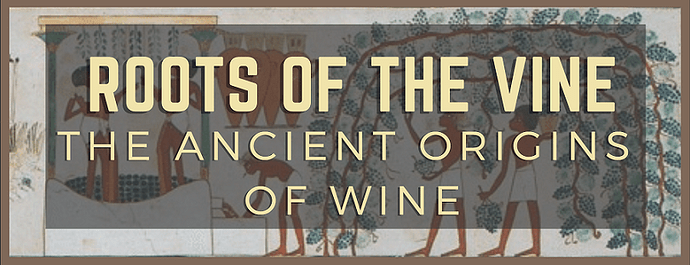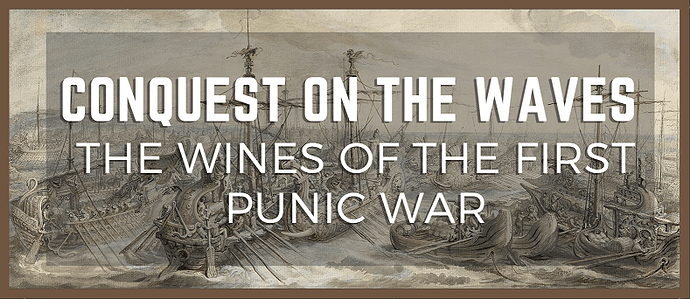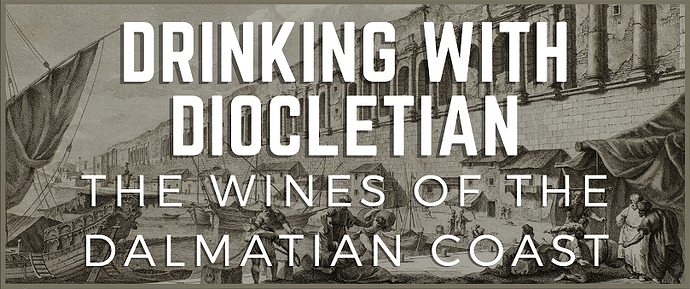ANCIENT HISTORY - ARCHAEOLOGY - MYTHOLOGY - FANTASTIC WINESWelcome Berserkers and Wine Explorers! We’re the Ancient Wine Guys.
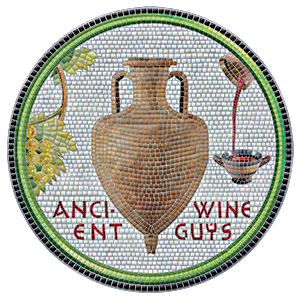
****UPDATE: Wow! Thank you Wine Berserkers for such an amazing response! As a thank you, we’re extending the offer until MIDNIGHT on Sunday 11/21/2021!
Additionally, we will be doing a Zoom tasting and discussion of Pack A with Wine Berserkers and Ancient Wines Club Members on December 2nd, 7-8PM PST, click here to see thread for details!
_Who are you guys?_****The Ancient Wine Guys (AWG) are a group of four wine industry veterans, professional historians, PhD archaeologists, and best friends dedicated to exploring and sharing the incredible wines and stories of the ancient world. We combine our collective array of professional, academic, and personal experience in archaeology, history, and education (plus a combined 25+ years of expertise in the world of wine) to curate the world’s only ancient history-archaeology-mythology-focused wine club: the Ancient Wines Club. In addition to the Club (see details below!), we also host a range of live and virtual wine dinners, tastings, seminars, and fundraisers. Check us out on Instagram @ancientwineguys, or on Facebook!
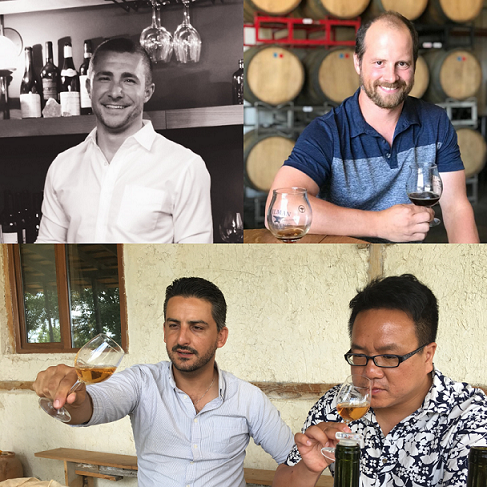
__****From top left, clockwise: Ryan Wihera, Dr. Jeff Pearson, Ti Ngo, Dr. Dana De Pietro
_Alright, what’s the offer?**_****For more than three years, AWG’s flagship product has been the bi-monthly Ancient Wines Club, a selection of three unique, delicious, small-production wines connected to a particular theme drawn from the history, archaeology, and mythology of the ancient world. With each shipment, members receive carefully-crafted, content-rich, full-color write-ups that thoroughly explore that club’s wines and theme. Our selections often feature hard-to-find wines, from unique regions, made from some of the world of wine’s most ancient, and historic varieties.
Our write-ups aim to meaningfully connect our wine selections to the places and stories that shape them. They are also designed to be fun, inspiring, engaging, and accessible to history buffs and wine enthusiasts of all levels, neophyte to expert. Our packs are a fantastic way to explore wine regions, varieties, and producers you may or may not be familiar with, all while getting a uniquely educational experience.
For WineBerserkers’ NewbiePalooza, we have selected four of our fan-favorite Ancient Wines Club packs, updated and revamped them for WineBerserkers, and are for the first time offering them as à la carte purchases with discounted shipping and a special WineBerserkers discount. That’s right, you’re not obligated to sign up for the club first - we simply want you to enjoy our wines and write-ups, and, of course, post about them on WineTalk! However, if you sign up, this exclusive 15% discount will carry forward to any Ancient Wines Club membership and other AWG wine purchases for all of 2022!
Whoa! OK, I love great wines, and I love exploring history! But first…How will I order?!** How to order the the individual Wine Berserkers Packs:Simply send us an email at info@ancientwineguys.com with your desired quantities of each pack, shipping address, and a phone number we can reach you at. We will follow up immediately with instructions and a link for completing your order!
Want to buy a pack as a gift? (Hint: these make awesome gifts for history and wine dorks alike!) Let us know!
****How to sign up for the discounted Ancient Wines Club:Sign up here! At checkout, enter the discount code BerserkersAWG to receive your exclusive 15% discount on all 6 of our upcoming 2022 clubs. Additionally, if you sign up for the Ancient Wines Club before January 1, 2022, shipping for your first club installment, to be mailed in early January, will be free! Let us know if you’d like to combine your Packs with your club and we can accommodate as well!
_Cool. So… what’s in the packs?_
[Pack A: Original Price: $75 - Berserker Price: $63.75]**
Featuring: Pack A features three exceptional wines selected from some of the world’s oldest, and most important regions connected to the history and origins of our beloved beverage.
2019 Orgo Saperavi Classic, elegant Georgian teinturier red aged in traditional qvevri/amphora.
Kakheti, Republic of Georgia - 100% Saperavi
2019 Cremisan Hamdani/Jandali White Blend
Dry, versatile white blend of two unique grapes indigenous to the Levant.
Bethlehem, Palestine, Israel - 50% Hamdani, 50% Jandali
2014 Lucien Arkas Bağları “Antre” Red Blend
Compelling blend of two native Turkish red varieties, Boğazkere provides Nebbiolo-like structure, while Öküzgözü imparts aromatic complexity.
Southeast Anatolia, Turkey - 50% Öküzgözü, 50% Boğazkere
Write-up Topics: From Wild Grapes to the Cups of Kings. Wine’s Genesis. Archaeology and Anthropology of Wine. Wine in Ancient Egypt and Mesopotamia.
Starting from the earliest records of wine and its cultures, we journey back nearly 8,000 years to the cradles of civilization to examine the beginnings of wine as we know it today. Here we also discover some of the first emerging elements of wine commerce and culture, such as labels, tasting notes, importing, and even ratings!
—
[Pack B: Original Price: $75 - Berserker Price: $63.75]
Featuring: Pack B features three sensational reds from Sicily and Sardinia, each showcasing some of the most important sites and regions of the First Punic War.
2013 Palari Rosso Del Soprano Complex, balanced, and perfectly aged Sicilian red blend from within the famed Faro DOC.
Sicilia IGT, Italy - 50% Nerello Mascalese, 20% Nerello Cappuccio, 20% Nocera and 10% Cappuccio Tignolino, Acitana, Galatena, and Calabrese
2019 Valle dell Acate “Case Ibidini” Nero D’Avola
Fresh, vibrant, immensely drinkable Nero d’Avola from within the Cerasuolo di Vittoria DOCG.
Sicilia IGT, Italy - 100% Nero d’Avola
2016 Cantina Gallura “Templum” Cannonau di Sardegna DOC
Impressively structured Sardinian Cannonau/Grenache with both pairing and cellar potential.
Sardinia, Italy - 100% Cannonau
Write-up Topics: A Struggle for Power. Vicious Sea Battles. The Rise of Rome.
Kicking off in 264 BCE, the First Punic War would lay the groundwork for more than a century of bitter, bloody conflict between Rome and Carthage, the two greatest powers of the ancient western Mediterranean world. This dramatic clash - the first of three Punic Wars - would forever shape the politics, history, and peoples of the Mediterranean.
—
[Pack C: Original Price: $75 - Berserker Price: $63.75]
Featuring: Pack C features three divine wines - one from Turkey and two from Greece - each connected with the ancient worship and reverence of Demeter as a mother-goddess and goddess of agriculture.
2018 Sevilen “Nativus” Narince Textured, aromatic, and vibrant dry white from native Anatolian variety Narince.
Eastern Anatolia, Turkey - 100% Narince
2017 Anatolikos Vineyards Limnio
Deep, spice/earth-focused complex red produced from the historic Limnio grape, first popularized by Aristotle.
Thrace, Greece- 100% Limnio
2020 Markou Vineyards “eMeis”
Energetic, youthful, unique red blend produced via carbonic maceration.
Attika, Greece - 50% Agiorgitiko, 50% Mandilaria
Write-up Topics: Duality. Growth. Vengeance. Madness. Myth. Archaeological Origins of the Goddess Demeter.
The Greek goddess Demeter was arguably the most powerful deity in the entire pantheon, representing not only the abundance of the harvest, but also the ravages caused by its dearth. Join us as we explore the archaeological and mythological origins of this supremely important mythological figure, her connections to the world of wine, and her place at the center of one of the ancient world’s greatest mysteries!
—
[Pack D: Original Price: $75 - Berserker Price: $63.75]
Featuring: Pack D features three uniquely delicious wines from the Dalmatian coast, each sourced from regions formerly part of Diocletian’s Roman Empire. Though you may not be familiar with the varieties, you will feel right at home drinking these wines.
2020 Toreta PošipCrisp, lively, almost Albariño-like white from the very island where the grape originates.
Korçula, Croatia - 100% Pošip
2017 Milos Plavac Mali
Rustic, structured, and expressive take on an old-world relative of Zinfandel.
Peljesac, Croatia - 100% Plavac Mali
2017 Monastery Tvrdos Vranac
Bold, intensely fruited, aged in large, old Monastery oak barrels, produced from an obscure, lesser-known cousin of Zinfandel.
Herzegovina, Bosnia - 100% Vranac
Write-up Topics: Dramatic Coastlines. Ancient Cultures. A Roman Palace of Wonders. An Emperor’s Dedication to the Good Life.
Often overlooked by even well-traveled wine connoisseurs, the wines of Dalmatia are diverse, delicious, and endlessly fascinating, a fact well-known and well-enjoyed by the Roman emperor Diocletian, a native and resident of the region. Join us as we explore the historic coastal regions of Croatia and Bosnia & Herzegovina, which hold thousands of years of some of the most important places, people, and vineyards of European history.
—
Awesome packs! Now, tell me more about this sweet, sweet Club discount…?
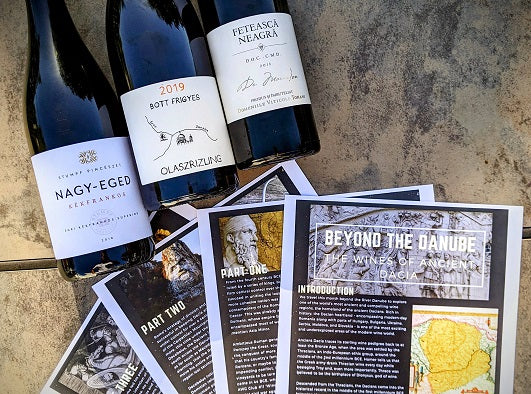
If you sign up here for the Ancient Wines Club before January 1, 2022 using offer code: BerserkersAWG, you will receive a 15% discount off the regular bi-monthly club price of $75 for all of 2022. For next year, we are also offering existing Ancient Wines Club members a year-long 15% discount for any new member they refer to the club, meaning if you sign up a friend next year, you can lock in this discount for all of 2023, too!
Clubs are billed and shipped every other month. Shipping for your first club, which will be mailed out in January, is free! Ancient Wines Club Members also receive a 15% discount on all wine purchases as well as discounts to our live and virtual events! The Ancient Wines Guys have created twenty unique clubs over the past three and a half years, including “The Wines of Alexander the Great,” “The Wines of Orpheus: Musician of the Gods,” and “Beyond the Danube: The Wines of Ancient Dacia” (pictured). Many, many more exciting clubs and topics await in the coming years, and we invite you to join us on the journey!
And finally, what about shipping discounts, shipping details, and the fine print?****Want to combine your Packs order with your club subscription? No problem! We can hold your wines and combine them to save on future shipping!
AZ, CA, ID, NM, NV, OR, WA: $15 flat-rate shipping, FREE shipping on any 3 or 4 pack purchase!.
All Other states: $25 flat-rate for up to 2 Packs; $30 flat-rate for 3 or more Packs (no limit).*
Free shipping for new club members: you will see the charge on the invoice for shipping based on your delivery location when you sign up, but we will fully refund this charge for the first club upon signup!
As much as we would love everyone to get their wines ASAP, currently all wines will ship in the first two weeks of December, unless otherwise requested. If you are traveling, out of town, or need us to wait to ship your wines with your first Ancient Wines Club shipment in January, please let us know and we can hold your wines for you.
- We currently do not ship to the following states: AK, AR, AL, DE, HI, IL, KY, MI, MS, RI, UT. However, if you are located in one of these states, please reach out to us with your order and we will see what we can do! Must be 21 or older to purchase. Inquire for any details.**
